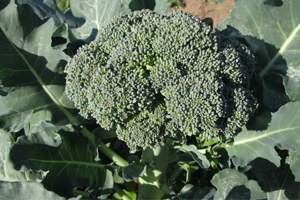Trying your hand at growing broccoli this year? In Central Texas a spring crop can be put in the ground from January 15 until February 15. It is best to start seed on your own if you can. Large, stressed or overgrown plants purchased at nurseries or department stores will “button” or not come true. Order seed from a reputable seed source such as Johnny’s Seeds http://www.johnnyseeds.com/ or Harris seeds http://www.harrisseeds.com/ Plant seeds one-half inch deep in paper cups with drainage holes in the bottom or small flower pots filled with sterile planting mix. Because seeds germinate in about a week, you can plant a few seeds every week for about a month to plant out during the January 15 to February 15 planting window, so you will have plants mature at different times. Everyone loves broccoli, but it’s hard to eat fifty heads in a week.
Position the planting pots so the new seedlings get plenty of bright light. If you put pots in direct sunlight, keep an eye on them so they don’t burn up. Keep moist, and as soon as you see a pair of true leaves form on the plants, fertilize with fish emulsion. Broccoli loves fish emulsion and although it smells a little, well, fishy, it will make broccoli grow really big heads. Just don’t put it directly on the part of the plant you want to eat. Pour it around the root zone.
While you are waiting to put out the broccoli plants, prepare the soil by adding lots of well rotted compost. Be sure that compost is well rotted because decaying organic matter can tie up the valuable nitrogen that broccoli plants must have to produce a nice head. Also, broccoli plants need a good supply of boron. If your soil is low in organic matter or a soil test shows low levels of boron, treat every 10 square feet of soil with one tablespoon of borax dissolved in three gallons of water. Add granulated organic fertilizer such as Ladybug brand or Medina brand as instructed on the fertilizer container.
When seedlings get two more sets of true leaves, set them out with plants 15 inches apart. Small broccoli plants can handle our winter weather and temperatures can dip down in the twenties before any damage is done. Try not to disturb the roots of the new seedlings when transplanting. The new seedlings will be a little stringy from being inside, so plant about one inch deeper than they were in the pot.
Fertilize every three weeks with fish emulsion. They grow slowly until the days start to get longer but will really start to move by the first of March. Harvest when the heads are still tight but full. If you are a broccoli lover, you’ll know when the heads are perfect. If the buds begin to get loose, they are past their prime but can still be eaten. I like to let a few go to flower, or bolt, and then sprinkle the yellow flowers over a salad for a special spring treat. After you cut the head from the stalk with a sharp knife, don’t pull up the plant immediately. Many times small heads will form on the sides below where you made the main cut.
Common broccoli pests are aphids which you can remove with a blast of water. Also, little green cabbage worms eat the leaves and occasionally the heads. Spray with Bt or spinosad mixture. Late in the season, harlequin bugs start attacking the leaves. Kill them with pyrethrum dust.
Don’t plant where plants from the cabbage family were planted the previous season. Vegetable companions are onions, carrots, beets, Swiss chard, spinach and lettuce. Herb companions are oregano, sage, rosemary, and dill.
More gardening info and book, plant and bulb sources at: http://www.biglump.com




